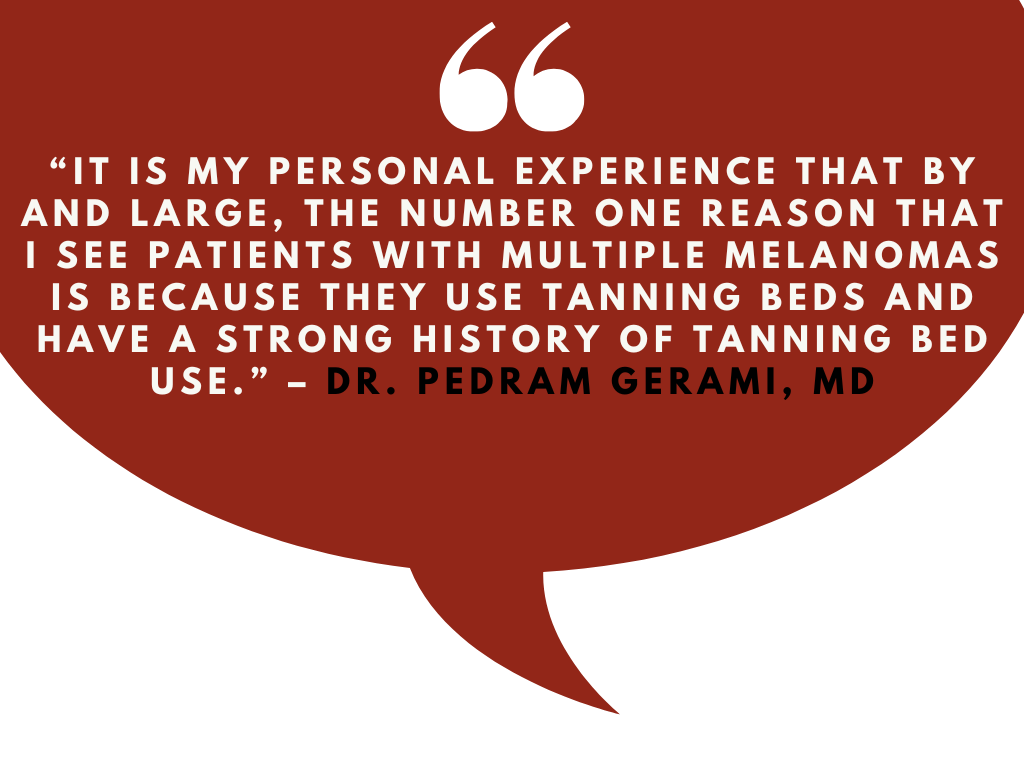- Acne
- Actinic Keratosis
- Aesthetics
- Alopecia
- Atopic Dermatitis
- Buy-and-Bill
- COVID-19
- Case-Based Roundtable
- Chronic Hand Eczema
- Chronic Spontaneous Urticaria
- Drug Watch
- Eczema
- General Dermatology
- Hidradenitis Suppurativa
- Melasma
- NP and PA
- Pediatric Dermatology
- Pigmentary Disorders
- Practice Management
- Precision Medicine and Biologics
- Prurigo Nodularis
- Psoriasis
- Psoriatic Arthritis
- Rare Disease
- Rosacea
- Skin Cancer
- Vitiligo
- Wound Care
Article
Indoor Tanning and Melanoma
Author(s):
The use of tanning beds has become a popular practice in society today, however, it remains undisputed that ultraviolet radiation from natural sunlight and indoor tanning machines increases an individual’s risk of developing skin cancer.
Pedram Gerami, MD

The well-established link between excessive ultraviolet (UV) radiation, whether from natural sunlight or from indoor tanning machines, and the development of all types of skin cancer is nothing new to dermatologists. However, a recent study1 clearly shows that the association between the use of tanning machines and the development of multiple primary melanomas is alarmingly high, with or without familial predisposition. It is therefore paramount that this very sobering fact be brought home to all clinicians and their patients and underscores the need for increased patient education regarding the very real dangers of this still popular social fad.
“It is my personal experience that by and large, the number one reason that I see patients with multiple melanomas is because they use tanning beds and have a strong history of tanning bed use,” said Pedram Gerami, MD, professor of dermatology and pathology, director of the Skin Cancer Institute of Northwestern Medicine (SCIN-med), and director of the melanoma program of SCIN-med at Northwestern University Department of Dermatology and the Lurie Cancer Center in Chicago, Illinois, and co-author of the study.
The risk of indoor tanning machine usage and the development of skin cancer has been known for quite some time. Nevertheless, many people still regularly visit tanning salons to get that "perfect tan," despite knowing about the risk and negative impact that UV exposure can have on their skin and general health.
Most skin cancers are caused by UV radiation from natural sunlight and/or tanning beds. While UVB rays cause sunburn, the UVA rays that are predominantly emitted by tanning machines lead to tanning as well as skin aging. However, any tan regardless of the source of UV radiation is a manifestation of DNA damage in the skin cells, just as sunburn is. It has now become common knowledge that the longer UVA wavelength penetrates deeper into the skin and is strongly associated with the development of melanoma.
“In our melanoma clinic, we see a lot of younger patients who have had multiple primary melanomas, and we use genetic testing to try and elucidate if there is a genetic bias as to why they develop melanomas, which are often multiple. In most of the cases, I find that the obvious is sometimes overlooked, namely, that these younger patients at a very young age often use indoor tanning machines to get their tan. It appears that the common denominator among these younger patients who have had multiple primary melanomas is their frequent use of tanning machines,” said Gerami.
Gerami and fellow colleagues recently conducted a case-control study to test the postulated relationship between the frequent use of indoor tanning machines and the development of multiple primary melanomas. Cases were defined as patients with 2 or more (2+) primary melanomas and controls as patients with a single primary melanoma. The study included 453 patients aged 20 to 70 years (mean 53 years) who had a diagnosis of at least one primary melanoma at Northwestern Memorial Hospital between January 1, 2015, and December 31, 2018.
Study data revealed that 335 patients (mean age 53 years) had a single primary melanoma and 118 patients (mean age 51 years) had multiple primary melanomas. Patients were then stratified by a history of more than 10-lifetime indoor tanning exposures versus 0 exposures. Here, it was found that the proportion of patients with more than 10 indoor tanning exposures increased from 65/335 (19%) for patients with a single primary melanoma to 10/19 (53%) for those with 4+ multiple primary melanomas. The researchers also found that the associated risk for multiple primary melanomas was significant for 2+, 3+, and 4+ melanomas in both univariate and multivariate analyses.
A systematic literature review and meta-analysis was also performed comparing the risk for multiple primary melanomas associated with the most common germline mutations in familial melanomas, which included high-penetrance (CDKN2A) and low-/intermediate-penetrance (MITF, MC1R) genes. The researchers calculated the risk for multiple primary melanomas associated with indoor tanning, family history of melanoma, and a germline mutation, finding that at 2+ melanomas, the risk associated with indoor tanning surpassed that of family history, and resembled the risk associated with germline mutations in MITF and MC1R. At these lower numbers of multiple primary melanomas, a germline mutation in CDKN2A was found to carry a greater risk. The data was limited for higher numbers of multiple primary melanomas but according to Gerami, this suggested that the risk related to indoor tanning may surpass that of low-/intermediate-penetrance germline mutations.

“If you look at the total burden of melanoma, the risk of indoor tanning machine usage carries a much higher burden because both the high-penetrance and mid-penetrance familial melanoma genes are relatively infrequent. However, when compared to the prevalence of indoor tanning machine usage to the prevalence of those genes, tanning bed usage is far greater. So, when you measure actual burden of melanoma disease resulting from these different factors, tanning bed usage is responsible for a much higher proportion because it is just so prevalent in our society,” said Gerami.
Indoor tanning machines expose the entire skin to harmful UV radiation and that will increase melanoma risk at any age, Gerami said. However, if they are frequently used at a younger age, by simple probability the user will have many more years in front of them to develop these precursor changes. The UV rays emitted from tanning machines essentially cause some of the critical mutations in the cells that will transform benign cells to melanoma cells.
“If you have a large area of your body that has one or two of these mutations at a young age, there is just a lot of chance that throughout the rest of your life when getting more sun, that you might get that additional hit that one would require to develop melanoma. We could impact prevalence and the burden of melanoma by eliminating or at least somehow convincing people to just refrain from using indoor tanning machines,” Gerami said.
Patient education is clearly paramount in getting the message out to have them understand the significant increased risk of melanoma associated with indoor tanning machines. Beyond the dermatologic visit, Gerami said that it is equally important that other specialists including pediatricians and general practitioners get involved to further inform their patients about tanning bed risks.
The younger population is the age where a lot of indoor tanning is being done and younger females should be particularly targeted for further education as they are probably epidemiologically the most frequent users of tanning machines. According to Gerami, tanning bed usage is the number one reason patients develop multiple melanomas, which is a fascinating phenomenon, as the process is completely preventable.
“An immediate intervention of bringing the patient in the office and finding a melanoma is very important and often consumes the visit time. However, I think a reminder of how important it is that even if the dangers of indoor tanning seem self-evident, physicians need to take the extra time for educational sessions. Unless we keep reminding people and keep bringing it up, the danger can often be quickly dismissed. I think it is crucial to take that extra time to focus on that educational component and in my practice, I have found that it makes a big difference,” Gerami concluded.
Disclosure
Gerami has served as a consultant for Myriad Genomics, DermTech Int, Merck, and Castle Biosciences, and has received honoraria for this study.
Reference
- Roth A, Boutko A, Lampley N, Olivares S, Gerami P. Indoor tanning is associated with an increased risk of multiple primary melanomas: A case-control study. Am Acad Dermatol. 2022 Nov 15;S0190-9622(22)02781-5. doi: 10.1016/j.jaad.2022.09.038. Online ahead of print.
- Photo credit: Rido/AdobeStock
Newsletter
Like what you’re reading? Subscribe to Dermatology Times for weekly updates on therapies, innovations, and real-world practice tips.















